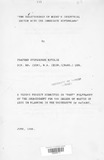| dc.description.abstract | This study examines the relationship of Moshi's
industrial sector with its immediate hinterland. The
aim is to find out the concrete relationships between
the two sectors in terms of economic linkages, both
forward and backward, and development disparity.
An analysis of the town is made by examining the
historical development of the town, its population and
its various land uses with an emphasis on the industrial
sector and whether prospects of further industrialization
do exist.
The study discusses the hinterland's economic
infrastructure, demographic and physical aspects as well
as the resource base. The latter parameter is examined
to see how far it has been exploited by the establishment
of industries in the town linked to the resource hinterland.
This study has found out that there is development
gap between the town and the hinterland. Further, the
industrial linkages that exist are weak and for the most
part are not geared towards the development of the hinter-
land; rather the town is parasitic' on the latter. The
established industries are more externally-oriented with
external linkages rather than internal. Although
the growth of the town has depended mainly on the resource
hinterland, the former gives little in return. These
problems are common to most industrial towns in Tanzania
whereby they simply act as a link between their respective
hinterlands and an external economy.
The study has provided a number of proposals which,
if implemented, will significantly alleviate the problems
discussed. The suggestions put forward call for a change
in the agricultural system, which is mono-cultural, and
to effect population resettlement in the less densely populated
areas of the region. To reduce unemployment and
under-employment, industrial investment, in addition to
increased agricultural productivity is necessary. In the
town, the kind of industries to be established are those
that improve the industrial linkages and have direct relationships,
as far as possible, to the resources of the hinterland.
It is through this way that an integrated and
balanced growth of the town and the hinterland can be
effected. The recommendations can be attained through
deliberate government initiative and the will and co-operation
of the people. It is hoped that this study will go a
long way in giving guidelines to alleviate problems of the
kind discussed here not only in Kilimanjaro area, but also
in all areas facing similar problems in Tanzania, in
particular, and the Third World in general. | en_US |

